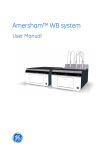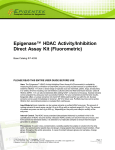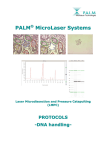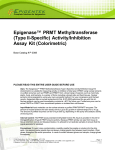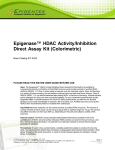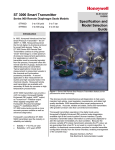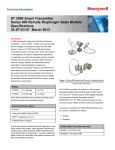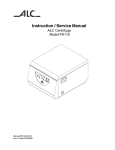Download User Bulletin - Thermo Fisher Scientific
Transcript
User Bulletin CATALYST 800/877 Integrated Thermal Cycler September 9, 1998 (updated 04/2001) SUBJECT: Routine Maintenance and Troubleshooting Overview Periodic maintenance of the CATALYST™ 800 and ABI PRISM® 877 Integrated Thermal Cycler is essential for optimum performance and prolonged life of hardware components. There are also some simple tasks you should perform before and after every run to save time, reagents, and precious samples. The recommended maintenance tasks and use of the enclosed Pre- and Post-run Checklist magnet and maintenance log are described in detail in this user bulletin. Topics in This User This document is an update to your instrument user’s manual and replaces Section 5. Bulletin The document contains the following topics: Topic Frequency of Performing Maintenance Tasks See page 2 Maintenance for Chemical Reagents 5 Miscellaneous Hardware and Other Maintenance 7 Maintenance of the Probe Tip and Thermal Cycler Plate 10 Maintenance of the Syringes 18 Maintenance of the Cooling System 20 Checklist Magnet and Scheduled Customer Maintenance Logsheet 24 Frequently Asked Questions 26 Utilities and Tests 28 Troubleshooting 32 Frequency of Performing Maintenance Tasks Pre-Run Tasks The tables below provide more information for the Pre-run tasks listed on the Pre- and Post-run Checklist magnet (reproduced on page 25), including references to additional information in this bulletin or in the user’s manual. Page 2 of 36 Task Description More information is provided... Check for sufficient volumes in reagent bottles (water, ethanol, buffer, bleach). under “Maintenance for Chemical Reagents” on page 5. Check and clean origins (trenches) as needed. under “Origin Trenches” on page 7. Check for clean, empty tube in position AC4-1 (877) or 300 µL of water (800–instruments with software earlier than version 2.0.3). under “AC4-1 Tube” on page 7. Compare the locations of samples and reagents on the worksurface with the load map depicted on the monitor. under “Load Map” in Chapter 2 of the User’s manual. Check that syringes are firmly connected and airtight. under “Maintenance of the Syringes” on page 18. Check that sufficient space exists in waste bottle for generated waste and make sure the waste line is fastened securely in place. under “Waste Bottle” on page 8. Task Description Action Check that liquids are present in the bottoms of sample and reagent tubes (no bubbles should be visible/introduced by pipetting). ♦ Add missing liquids, referring to the Load Map. ♦ If bubbles are present in a sample or reagent tube, centrifuge the tube to remove and replace the tube in the correct position. Check that cold storage blocks and racks are properly seated with white plastic lids snapped into hinges and closed. ♦ If a block is not seated properly, press into place firmly. ♦ If a plastic lid is not secured properly, snap it into its hinge (if needed) and close it properly. Check that reagent delivery begins and all temperature targets are met about 15 minutes after the start of a run. This is a check for proper instrument operation as robot initialization takes about this long on a properly functioning instrument. CAUTION The waste bottle should never be more than half full before a run. User Bulletin User Bulletin: CATALYST 800/877 Integrated Thermal Cycler Post-Run Checklist The table below provides more information for the Post-run tasks listed in the checklist Tasks on page 25. Task Description Significance Check that the final tube volumes (reagents, samples, products) are as expected. Uneven or unexpected volumes may indicate a problem to be investigated. Check log file for error messages. This information is invaluable in diagnosing instrument problems. Note the exact wording of any error message in the log file as well as the statements presented immediately before and after each error message. Make sure that the cold storage lids and the instrument door are closed. This reduces condensation on the cold storage blocks. Weekly Tasks Perform the following tasks weekly to ensure proper instrument operation: Task Description More information is provided... Replace AC4-1 tube under “Miscellaneous Hardware and Other Maintenance” on page 7. Rinse buffer and bleach bottles and refill under “Maintenance for Chemical Reagents” on page 5. Clean external H2O and EtOH bottles (if needed) and refill under “Maintenance for Chemical Reagents” on page 5. Clean origin trenches under “Origin Trenches” on page 7. Run Purge Well Utility under “Purge Wells Utility” on page 9. Empty waste bottle under “Waste Bottle and Tube” on page 8. User Bulletin User Bulletin: CATALYST 800/877 Integrated Thermal Cycler Page 3 of 36 Monthly Intervals Perform the following tasks monthly to ensure proper instrument operation: Task Description More information is provided... Remove, clean, and oil TC plate under “Monthly Removal, Cleaning, and Oiling of the Thermal Cycler Plate” on page 12. Remove/inspect syringes under “Maintenance of the Syringes” on page 18. Use the hardware change utility to remove syringes and check for signs of leakage, discoloration, or worn plunger. This reference provides information about Note expected service life. Remove/inspect TC lid gasket under “Thermal Cycler Lid Gasket” on page 8. Check/fill coolant level under “Coolant Level” on page 20. Three/Six Month Perform the following tasks every three/six months to ensure proper instrument Intervals operation: Page 4 of 36 Task Description Interval More information is provided... Replace TC lid gasket Every 3 months and when replacing TC plate under “Thermal Cycler Lid Gasket” on page 8. Replace probe tip Every 3 months (PCR only) or every 6 months (sequencing only) under “Removing and Replacing the Probe Tip” on page 11. Replace TC plate and gasket Every 3 months (PCR only) or every 6 months (sequencing only) ♦ Procedure for plate replacement ♦ Procedure for gasket replacement under “Monthly Removal, Cleaning, and Oiling of the Thermal Cycler Plate” on page 12 (follow instructions in note before first procedure). under “Thermal Cycler Lid Gasket” on page 8. User Bulletin User Bulletin: CATALYST 800/877 Integrated Thermal Cycler Maintenance for Chemical Reagents Pre-Run Make the following checks before each run: ♦ Make sure that 50 mM Tris/Tween buffer (0.01% Tween™ and 50 mM Tris pH 8.0) and 2.0% sodium hypochlorite wash bottles in the heated storage area are clean and full, solutions are clear with no precipitates, and there are no crystals on the bottle surfaces. ♦ Check that external water and ethanol diluent bottles contain enough fluid for the run, and their delivery lines are in place and properly connected. Weekly Maintenance Do the following weekly: ♦ Rinse the Tris/Tween buffer bottle with DI water and refill with 50 mM Tris/Tween. ♦ Rinse the bleach wash bottle with DI water and refill with 2% sodium hypochlorite solution. Some users may want to replace more often. See “Maintenance of the Probe Tip and Thermal Cycler Plate” on page 10. ! WARNING ! CHEMICAL HAZARD. Sodium hypochlorite is a corrosive chemical that can burn and cause serious skin or eye damage. Always work in a fume hood. Obtain a copy of the MSDS from the manufacturer. Wear appropriate protective eyewear, clothing, and gloves. ♦ Refill the DI water bottle, cleaning it (if necessary) before refilling. ♦ Refill the ethanol bottle with 95% ethanol, cleaning it (if necessary) before refilling. See grade recommendation under “Purity of Ethanol” below. ! WARNING ! CHEMICAL HAZARD. Ethanol is a flammable chemical and is irritating to the skin, eyes, respiratory system. It can cause nerve and liver damage, CNS depression, nausea, vomiting, and headache. Always work in a fume hood. Obtain a copy of the MSDS from the manufacturer. Wear appropriate protective eyewear, clothing, and gloves. Actions to Avoid Avoid topping off the ethanol, Tris/Tween, or bleach bottles by adding more liquid to a partially full bottle. This may cause inconsistent reagent concentrations over time. Why Replacement Is Replace the Tris/Tween solution because it evaporates and concentrates when left Important standing. Also, Tris/Tween precipitates form. Be sure to remove them from the bottle lid area as they can clog the probe tip, causing intermittent pipetting volume errors and sometimes causing right syringe pump overload. The latter is a fatal error and will abort the run in progress. Be precise when preparing the sodium hypochlorite solution because the concentration values are optimal in a very small window. If too concentrated, the solution will reduce plate life. If the concentration is too dilute, the cleaning effectiveness is reduced. Purity of Ethanol We recommend that the ethanol used for line flushing, syringe priming, and cleaning or drying of surfaces be of molecular biology grade, so as to contain as few impurities as possible. User Bulletin User Bulletin: CATALYST 800/877 Integrated Thermal Cycler Page 5 of 36 Purity of Water We recommend that the DI water used be the highest grade available (e.g., Milli-Q™) so as to contain as few impurities as possible. Page 6 of 36 User Bulletin User Bulletin: CATALYST 800/877 Integrated Thermal Cycler Miscellaneous Hardware and Other Maintenance General The following are described in this subsection: ♦ AC4-1 tube ♦ Origin Trenches ♦ Waste Bottle ♦ Thermal Cycler Lid Gasket ♦ Purge Well Utility ♦ Troubleshooting Procedure for Start-up Problems The AC4-1 tube, origin trenches, waste bottle, and thermal cycler lid gasket are hardware items requiring regular maintenance. The first three items (AC4-1 tube, origin trenches, and waste bottle) are listed as pre-run checks and also have maintenance performed on a weekly basis. The thermal cycler gasket requires maintenance on a monthly basis. The last two items (Purge Well Utility and Troubleshooting Procedure for Start-up Problems) are provided to avoid or correct hardware and operational problems. AC4-1 Tube Purpose of the Tube The AC4-1 tube wicks water off of the probe tip to ensure accurate mapping of the worksurface origin. Weekly Maintenance For all systems and configurations, change the tube weekly. Then do the following: ♦ For 800 instruments (instruments prior to Ver. 2.0.3 software), add 300 µL of DI water. ♦ For 877 instruments, leave the tube empty. Why Replacing the Tube Is Important Replacing the tube will reduce the likelihood of contamination from this source. Origin Trenches Weekly Maintenance On a weekly basis, carefully clean the origin trenches with ethanol (see “Purity of Ethanol” on page 5) and a Kimwipe. Check that no pieces of tissue or lint are left behind. The origin trenches are the two L-shaped cutouts near the front and back of the left Note side of the worksurface. Water and debris trapped in the trenches interfere with the initialization routine. Why Cleaning Trenches Is Important Keeping the trenches clean is important to ensure accurate mapping of the worksurface. If the origin trenches are dirty, the system’s capacitance detection system receives a weak signal, leading to inaccurate mapping of the origin. This is a critical function for small volume pipetting, which must have accurate probe tip information to execute properly. User Bulletin User Bulletin: CATALYST 800/877 Integrated Thermal Cycler Page 7 of 36 Waste Bottle and Pre-Run Tube Check that the waste bottle is no more than half full, and the waste tube is securely in place inside of the bottle. The end of the waste tube should drop only slightly below the top of the bottle and should not be submerged in waste liquid. Weekly Maintenance Empty the waste bottle. Why Regular Waste Emptying Is Important Maintenance intervals vary with frequency of use. Some users have relatively modest sample throughput, and should check waste weekly. For those users with high throughput, the waste level should be inspected daily, pre-run. Emptying the waste regularly is essential to prevent waste back up. In addition, the user can help to prevent vapor lock/gravity lock by ensuring that the waste tubing follows a gradually continuous downward slope to the bottle, and that the tubing is not submerged in the waste liquid. Waste backing up and overflowing onto the robot worksurface during a run is very Note likely to contaminate the probe tip, which then contaminates the reactions. If the waste problem is not corrected before the start of the ensuing run, the robot will fail worksurface mapping and shut the instrument down, not allowing reaction setup for the run. Thermal Cycler Lid Monthly Maintenance Gasket Perform a visual inspection of the lid gasket using the Hardware Change utility to open the lid. Inspect it carefully, and if any solids are present on the gasket surface, perform the following cleaning procedure. Failure to do lid gasket maintenance may increase evaporation of reactions, sample Note contamination, and evaporation test failure. The presence of solids on the gasket may indicate pipetting problems. To clean the thermal cycler lid gasket: Step Action 1 Remove the lid gasket from the thermal cycler lid, removing the set screw if one is present. 2 Rinse thoroughly with distilled water, and allow the gasket to dry completely at room temperature. CAUTION Wiping the gasket dry risks potential scratching by contaminants (dust, lint, paper particles, etc.). 3 Carefully reinstall the lid gasket on the thermal cycler, using the triangular imprint to insure correct orientation. Why Maintaining the Lid Gasket Is Important Failure to perform lid gasket maintenance may increase evaporation of reactions, sample contamination, and evaporation test failure. In addition to inspecting for the presence of solids on the gasket, the user should look for a uniform impression of the thermal cycler wells. If significant variation is Page 8 of 36 User Bulletin User Bulletin: CATALYST 800/877 Integrated Thermal Cycler discovered, replace the gasket. Because the sealing material loses elasticity, the average expected life of this part is 3 months. Every Three Months Replace the lid gasket at this interval and whenever the thermal cycler plate is replaced. Purge Wells Utility Weekly Maintenance Run the Purge Wells Utility from the software as described in the table under “Utilities and Tests” on page 28. Why Use of the Utility Is Important In most cases, an additional cleaning cycle performed on the thermal cycler plate can help prevent the gradual build up of reaction contaminants. This simple maintenance task has been proven to extend the life and improve the performance of the plate. Users routinely running PCR may not need an extra purge. Troubleshooting This is the procedure recommended under “Troubleshooting” on page 32 when the Procedure for following dialog box message is presented during operation of the ABI PRISM 877 Start-up Problems system: Could not connect to ABI PRISM 877 . . . . .wait 10 (15) seconds and try again. In response to this message, attempt to connect again. If the error dialog box message is repeated, use the following procedure to connect: Step Action 1 Power down both the 877 and the Macintosh. 2 Power up the Macintosh. 3 Find the Terminal application. This application is represented by a telephone icon and is often located in a folder with the name “service” in the title. 4 Double-click the Terminal application to open it. If terminal opens without errors, you will see a blank window and several menu items along the top menu bar. Proceed with step 7. 5 If there are any errors announced as Terminal opens, quit the Terminal application and open the Chooser window from the Apple menu. 6 Make AppleTalk inactive and try opening Terminal again. If errors are announced again, quit this procedure and call ABI Technical Support. If you have been able to open Terminal without errors, continue with this procedure. 7 Turn on the 877. Within 5 seconds a “boot message” should appear in the open Terminal window. If nothing appears, quit this procedure and call ABI Technical Support. 8 Now launch the 877 software from the Macintosh and then start any 877 protocol. If normal communication has not been re-established by this procedure, call ABI Technical Support. User Bulletin User Bulletin: CATALYST 800/877 Integrated Thermal Cycler Page 9 of 36 Maintenance of the Probe Tip and Thermal Cycler Plate Introduction The probe tip and thermal cycler plate are considered together for maintenance since they are replaced simultaneously and require special attention to determine and maximize the life expectancy. The maintenance scheduled for these components includes: Maintenance Task Interval Remove/clean/oil TC plate Monthly Replace probe tip and thermal cycler plate Every 3 months, if performing PCR Note Every 6 months, if performing sequencing For optimum performance, follow these recommendations exactly. The schedule listed above generally provides the best operation but it is difficult to state an absolute life expectancy for these components since the service life in each case will vary based on a number of factors, including chemistry and throughput. The table below lists additional factors which affect the service life. Factors with negative impact shorten the service life and factors with positive impact lengthen the service life. Factors influencing component life: Positive Impact Negative Impact Regularly cleaning reagent bottles Allowing precipitates to form in reagents Making fresh reagent stock regularly Failing to refresh reagent stock Keeping sodium hypochlorite solution concentration at 2% Using over concentrated sodium hypochlorite solution Using chemistry-grade sodium hypochlorite solution of known concentration Using sodium hypochlorite solution of unknown concentration and/or quality The procedures for the replacement of the probe tip and the procedures for the monthly removal, cleaning, and oiling of the thermal cycler plate are provided in this section. Inspecting and Use the following procedure to inspect and clear a probe tip, either before installing a Clearing the Probe new probe tip or whenever a probe tip is to be reused after it is removed: Tip To inspect and clear the probe tip: Step Page 10 of 36 Action 1 Check the probe tip against a light source to see if the opening is clear. 2 If the probe tip opening is even partially blocked, blow pressurized air though the tip and check again. 3 Repeat step 2 until the tip is clear. 4 Wipe the outside of the probe tip with ethanol. 5 If the blockage cannot be cleared, replace the probe tip with a new one. User Bulletin User Bulletin: CATALYST 800/877 Integrated Thermal Cycler Removing and Use the following two procedures to remove and replace the probe tip: Replacing the Probe To remove the probe tip: Tip Step 1 Action Run the Hardware Change utility. ! WARNING ! PHYSICAL INJURY HAZARD. Do not open the door until the green indicator light turns off, and do not attempt to defeat the safety interlock system. It is designed to protect you from movements of the robotic arm. 2 When the green light on the front of the instrument goes out, open the door. The robot assembly will be in the Park position. Take notice of this position Note and then move the robot for easier access to the probe tip. 3 Unscrew the lower thumbscrew on the probe, and carefully slide the capacitive sensor out from between the thumbscrews. The capacitive sensor is a silver, U-shaped clip attached to a black wire as Note shown below. Notice the orientation of the sensor and sensor cable before removing, since it is important to reinstall the sensor and cable in the same position/orientation. Probe casing Sensor Cable Probe tip Thumb nut Capacitive sensor Thumb screw 4 Unscrew and remove the large thumb nut on the probe. 5 Remove the probe tip by dropping it down and out of the probe casing. To replace the probe tip: Step 1 Action Carefully inspect the new probe tip to make sure it is clear. Refer to “Inspecting and Clearing the Probe Tip” on page 10 for instructions on inspection and clearing. 2 Place the new probe tip in the thumb nut, so that it protrudes from the bottom of the nut. User Bulletin User Bulletin: CATALYST 800/877 Integrated Thermal Cycler Page 11 of 36 To replace the probe tip: (continued) Step Action 3 Lift the thumb nut containing the probe tip up to the casing, rotating as necessary to place the square end of the new probe into the probe casing, and carefully tighten the thumb nut to firm finger-tightness only. 4 Hold the capacitive sensor up against the thumb nut, with one hand, so that the probe is in the center of the sensor. Capacitive sensor and cable should be positioned/oriented as they were Note before removal. 5 Place the small thumbscrew over the probe with the screw side up, slide it up firmly against the capacitive sensor, and carefully tighten the thumb screw to finger-tightness only. If the sensor/cable assembly rotates while tightening, hold the thumb nut firmly with one hand and use the other hand to complete tightening of the thumb screw. Monthly Removal, Cleaning, and Oiling of the Thermal Cycler Plate 6 Return the robot to the Park position. 7 Close the instrument door and press the Resume switch. Use the following two procedures during monthly service of the thermal cycler plate. These procedures can also be used to replace a thermal cycler plate at the 3 month/6 Note month replacement interval and to address failures of 2 µL volume deliveries on the Pipetting Test (see discussion under “Pipetting Test Failures” on page 36). To replace a thermal cycler plate, first remove the old thermal cycler plate (as described in the first procedure) and then use steps 3 through 6 of the second procedure to install the new plate. To remove the thermal cycler plate: Step Action 1 Run the Hardware Change utility to open the thermal cycler lid. 2 Open the instrument door only after the green light on the front of the instrument goes out. 3 Loosen the four screws (referring to the figure below) in the thermal cycler plate with the 5/64-inch Allen wrench provided with the instrument, and carefully set the screws aside. Notch Pointer Notch Thermal cycler base Page 12 of 36 4 Lift the thermal cycler plate off of the base and remove. 5 Continue servicing the thermal cycler plate as described in the following procedure. User Bulletin User Bulletin: CATALYST 800/877 Integrated Thermal Cycler To clean and oil the Thermal Cycler Plate: Step Action 1 Rinse wells thoroughly with a stream of distilled water from a squeeze bottle, then force the water out of the wells by shaking the plate vigorously downward over a sink. 2 Rinse wells thoroughly with a stream of ethanol from a squeeze bottle, again forcing the liquid out by shaking the plate, and allow the plate to dry completely at room temperature (see “Purity of Ethanol” on page 5 for information about the recommended purity of ethanol). For an alternative to air drying, for users with a centrifuge with swing Note buckets, see “Alternative to Air Drying” on page 14. 3 Apply one or two drops of light mineral oil to the back of the thermal cycler plate and wipe it with a Kimwipe to spread it evenly over the plate. 4 Wipe the top surface of the thermal cycler base with the same tissue to create an even coating of oil on both the base surface and the back of the plate. Do not drop oil on the thermal cycler base, as excess oil may IMPORTANT cause problems. 5 Place the thermal cycler plate back into position on the thermal cycler base (referring to the figure in the previous procedure). 6 Tighten the four screws with the Allen wrench. CAUTION When reinstalling the thermal cycler plate, do not overtighten the screws. This will strip the screw holes and require replacement of the thermal cycler block. If you replace a 96-well thermal cycler plate with a 384-well plate, IMPORTANT be sure to use a new lid gasket or one previously used with 384 wells. The rubber indents on a used gasket must match the thermal cycler plate. User Bulletin User Bulletin: CATALYST 800/877 Integrated Thermal Cycler Page 13 of 36 Alternative to Air An alternative to using ethanol and air drying for thermal cycler (TC) plates is to invert Drying the TC plate onto a paper towel and spin the excess water off in a centrifuge with swing buckets. This works really well, is faster than waiting for a plate to dry, and eliminates the possibility of ethanol (or any of the impurities found in lab grade ethanols) remaining on the plate. Recognizing Component Degradation or Failure Importance of Monitoring Component Conditions To optimize the performance of the instrument, it is important to recognize degradation or failure of either the probe tip or the thermal cycle plate so that corrective action can be taken or so they can be replaced. This is especially important in the following cases: ♦ Whenever such degradation or failure occurs before maintenance or replacement would be performed as part of the maintenance schedule (see the maintenance schedule on page 10). ♦ When you are committed to obtaining as long a service life as possible from the probe tip and thermal cycle plate before replacement. Monitoring Component Conditions The condition of the probe tip and thermal cycler plate can be monitored by visual inspection: ♦ Between regularly scheduled maintenance so as to be aware of incipient problems developing. ♦ Whenever a review of analyzed data indicates poor quality of 800/877 products. The analyzed data for products produced on the 800/877 can be examined to see if Note there are any cues indicating probe tip or thermal cycler plate degradation. Visual and Other Cues for Component Degradation or Failure A number of symptoms will alert you to degradation or failure of the plate and/or probe tip. These include visual cues such as visible oxidation or other contamination, Teflon shavings on the worksurface due to the probe hitting the wash station, and overspray. Other cues, determined by reviewing analyzed data include dropouts, reduced yield, etc. Page 14 of 36 User Bulletin User Bulletin: CATALYST 800/877 Integrated Thermal Cycler Discussion of The most common failures for the probe tip and thermal cycler plate are discussed Failures here to aid you in maintaining these components. Probe Tip Failures and Corrective Actions The table below provides information and corrective actions for the two most common failure modes of the probe tip: Table of Failures Failure Caused by... Carry-over of reagent cocktail during distribution surface conditions on the outside surface at the end of the probe tip. This failure tends to increase in frequency as the tip gets dirty or with time and bleach exposure. poor probe tip position in the thermal cycler well when cocktail is delivered to any given well. Characterized by... little or no cocktail being deposited in one well and “double delivery” of cocktail to the next position. This is indicated by: ♦ ♦ variable or unexpectedly high residual volume in cocktail or sample tubes, or variable pooled product volumes User Bulletin User Bulletin: CATALYST 800/877 Integrated Thermal Cycler What this looks like... What to do on the electrophoresis data: Change the tip and log the change on the maintenance record The gel will exhibit a low/high pattern of unused primer in adjoining lanes. on the machine: Use the Syringe Note Prime Utility (Diagnostics menu) to look for the phenomena below. The probe tip will tend to hang onto liquid or liquid will be observed “climbing the tip” under the following conditions: ♦ While the tip is at rest over the waste station ♦ While the syringe is pushing water through the tip as it sits over the waste station in the rinse mode ♦ While the probe tip is moving slowly up out of the small hole (the wash station) ♦ While the probe tip is moving slowly up out of the AC4-1 tube Page 15 of 36 Table of Failures (continued) Failure Caused by... Major flow restriction in the probe tip contaminants introduced into the liquid path that become lodged (often temporarily) in the probe tip. Characterized by... What this looks like... What to do generally poor liquid handling. on the electrophoresis data: ♦ See “Error #82” on page 34 for a procedure to evaluate flow restrictions in the tip. ♦ Check reagent bottles as possible sources of particle contaminant. Clean as required. ♦ Check samples as possible sources of particle contaminant. Clean or improve prep as required. The key to recognizing this failure mode is that it affects contiguously positioned reactions, typically several and sometimes all samples on the machine: ♦ Variable or unexpectedly high residual volumes in cocktail or sample tubes, or variable pooled product volumes ♦ Overspray from the probe tip during waste delivery or rinsing. The worksurface around the waste/wash station will be wet. ♦ Instrument shutdown, Pump overload error. Complete flow restriction in the probe tip can cause a shutdown error on the right syringe pump as pressure builds in the liquid path and slows the travel of the syringe. Page 16 of 36 There is Note no need to replace probe tip if particles can be cleared. See “Inspecting and Clearing the Probe Tip” on page 10. User Bulletin User Bulletin: CATALYST 800/877 Integrated Thermal Cycler Thermal Cycler Plate and End of Service Life The table below provides information about the two most common end of life scenarios for the thermal cycler plate, which are very chemistry dependent: End of Life Scenario Thermal Cycler Plate Usage Data End of Service Life Symptoms/Considerations Bleach exposure Applied Biosystems has demonstrated that PCR efficiency on the 800/877 thermal cycler plate remains stable through 100 bleach clean-ups or purge cycles. Although there is variability in the resistance to bleach plate-to-plate due to the plastic deposition process, all plates should meet that 100 cycle minimum. ♦ When any given well on the thermal cycler plate reaches end of life due to bleach exposure, PCR efficiency drops dramatically and fragment production falls below the limit of detection. ♦ Contiguous wells tend to fail in the same time frame since regions of the plate wear together. When wells begin to fail, they will continue to fail. Tracking PCR success, looking for repeated failures of specific wells will clearly demonstrate the point in time when the plate needs to be changed. Timely action will prevent a rapid drop in yield. ♦ Contaminant deposition Contaminant deposition tends to be associated with the cycle sequencing reaction rather than with PCR. The deposition process is very DNA prep dependent and is characterized by data that shows evidence of contaminant peaks that can be removed by aggressive plate cleaning but that return with use on a period that relates to the cleaning process. User Bulletin User Bulletin: CATALYST 800/877 Integrated Thermal Cycler To summarize the above, a number of symptoms will alert you to degradation or failure of the plate and/or probe tip. These include: – reduced yield – dropouts – visible oxidation or other contamination Aggressive plate cleaning removes contaminant peaks, restoring productivity for a limited period, but accelerates the rate of bleach exposure (the other factor in the end-of-service life). Page 17 of 36 Maintenance of the Syringes Pre-Run Procedure for Inspection To keep both syringes in optimal condition, perform the following quick inspection: Step Action 1 Tighten the glass barrel of the syringes firmly. 2 Tighten the thumbscrew to finger tightness. 3 Inspect both syringes for droplets of water beside the barrels below the Teflon seals. Moisture there indicates worn seals. Replace the syringe if moisture is found. Luer fitting Teflon seal Barrel Finger tighten syringes and thumb screws by turning firmly to the right. Plunger Why Pre-Run Syringe Maintenance Is Important The short list of simple Pre-run actions will help you to regularly take every precaution necessary to ensure reliable use. The syringes have a slight tendency to “unscrew themselves” from the luer fittings, which can cause a failure of the seal between the syringe and the valve. This stops all liquid movement. A quick check of the thumbscrew tightness at the bottom of the syringe plunger (not shown in figure above) will ensure that the plunger/drive shaft connection is secure. Finally, a quick inspection of the plungers of both syringes, may reveal liquid that has pushed past or “blown by” the seal. This may indicate that syringe replacement is necessary. Page 18 of 36 User Bulletin User Bulletin: CATALYST 800/877 Integrated Thermal Cycler Monthly To ensure proper operation, do the following monthly: Maintenance Step Action 1 Use the hardware change utility to remove syringes. 2 Check both for signs of leakage, discoloration, or worn plunger tip. Replace a syringe which exhibits any of these signs. 3 Pull and push syringe plunger and feel for slippage in plunger motion. Replace a syringe if its plunger does not move smoothly. Typical life varies with use, but averages about 1 month for the small and 2 months for the large syringe (assuming daily use). User Bulletin User Bulletin: CATALYST 800/877 Integrated Thermal Cycler Page 19 of 36 Maintenance of the Cooling System Coolant Level Monthly Maintenance Check the coolant level and add coolant as required. (For details on the cooling system, refer to the appropriate user’s manual.) Types of Chillers The CATALY ST/877 currently uses 2 different types of chillers: the earlier unit using Syltherm coolant and a newer CFC-free unit using 50% Prestone Long Life Coolant diluted with distilled water. We recommend that you inspect the chiller in your instrument at least once a month and, if necessary, add the appropriate amount and type of coolant according to instructions in this section. Always use Syltherm (P/N 200988) or Prestone® Extended Life silicate and IMPORTANT phosphate-free coolant (P/N N8016186) supplied by Applied Biosystems. With any other coolant you risk incompatibilities which may damage your instrument. ! WARNING ! HEALTH HAZARD. Prestone Long Life Coolant may cause respiratory tract, skin, and eye irritation. Syltherm may cause eye irritation. Wear chemical-resistant gloves and safety glasses. Always use these chemicals in a well-ventilated area. Refer to the Site Preparation and Safety Guide (P/N 904567) which contains the MSDS with detailed information regarding these chemicals. As is stated in the Site Preparation and Safety Guide, “No hazardous waste is Note produced as a result of chemicals Applied Biosystems ships with the ABI PRISM® 877.” Procedures Three procedures are provided for checking and adding coolant: ♦ A procedure for removing the left side panel ♦ A procedure for inspecting the chiller ♦ A procedure for selecting the coolant and filling the chiller Removing the Left Side Panel The following illustration shows the rear of the instrument with the three screws and left side panel being removed. Perform the steps in the following procedure to remove the panel in order to inspect the chiller unit inside. Page 20 of 36 User Bulletin User Bulletin: CATALYST 800/877 Integrated Thermal Cycler ! WARNING ! ELECTRICAL SHOCK HAZARD. Severe electrical shock, which could cause physical injury or death, can result from removal of any outside instrument panels while the high-voltage power supply is operating. Turn off the power supply to the instrument, unplug the power cord, and wait at least 1 minute before removing outside panels. To remove the left side panel Step Action 1 Turn off all power to the instrument and take the other steps listed in the Warning above before proceeding. 2 Remove the three screws on the back holding the left side panel in place (In some cases you may also need to loosen the two screws holding the top cover.) 3 Pull the sides of the panel first toward you, then up to release it from the body of the instrument, and then set it aside. Inspecting the Chiller To determine which coolant to use: Step 1 Action Inspect the chiller, and compare it to the two shown in the figure below to identify the type of chiller installed on your instrument. If your chiller looks like the unit on the left you must use Syltherm coolant. If it looks like the unit on the right, use 50% Prestone Long Life Coolant. Syltherm chiller cap fill line 50% Prestone Long Life Coolant chiller cap Syltherm must never be mixed with water. Prestone Long Life IMPORTANT Coolant must be diluted 1:1 with distilled water. 2 Use the appropriate step for your chiller: a. If your chiller requires Syltherm, check the level of coolant in the overflow bottle. The bottle should be at least 2/3 full of Syltherm, and the tube should be suspended in the Syltherm approximately 1/2 inch from the bottom. These conditions prevent water intake, as water will separate from Syltherm and move to the bottom of the bottle. If the tube touches bottom, it will pull water instead of coolant. b. If your chiller requires 50% Prestone Long Life Coolant, unscrew the cap on the chiller (you may need to use a medium-size adjustable wrench) and look inside. The coolant level should be within an inch of the top, near the bottom of the interior threads. User Bulletin User Bulletin: CATALYST 800/877 Integrated Thermal Cycler Page 21 of 36 To determine which coolant to use: (continued) Step 3 Action If your chiller unit has an adequate amount of coolant, screw on the cap to finger tightness, and replace the side panel. You are now finished with the cooling system inspection. 4 If you need to add coolant to the chiller, proceed to the procedure immediately below (Selecting Coolant and Filling the Chiller). Selecting Coolant and Filling the Chiller Select and prepare the appropriate coolant as follows. To use Syltherm and fill the reservoir: Step 1 Action Remove the cap from the overflow bottle, and pour undiluted Syltherm directly from the shipping container into the overflow bottle until it is approximately 2/3 full. CAUTION Do not allow water to contaminate the Syltherm. 2 If water or debris are visible in the overflow bottle, empty it, rinse with 100% ethanol and refill. 3 Recap the bottle, tightening it to finger-tightness. 4 Check the plastic tube from the overflow bottle to the chiller to ensure that it is firmly attached and suspended in the Syltherm approximately 1/2 inch from the bottom of the overflow bottle. 5 Replace the side panel and the three screws in the back firmly tightening them with a screwdriver. To prepare 50% Prestone Long Life Coolant and fill the reservoir: Step Page 22 of 36 Action 1 Mix 100 mL distilled water and 100 mL Prestone Long Life Coolant. 2 Pour in the 50% Prestone Long Life, filling it up to the bottom of the interior threads. 3 Replace the coolant reservoir cap, tightening it to finger-tightness. User Bulletin User Bulletin: CATALYST 800/877 Integrated Thermal Cycler To prepare 50% Prestone Long Life Coolant and fill the reservoir: (continued) Step 4 Action Replace the side panel and the three screws in the back. Tighten the screws firmly with a screwdriver. Why Coolant Be sure to use only coolant sold by Applied Biosystems. The coolant we supply is Maintenance Is tested for additives to insure compatibility with our chemistries. Important Very slow leaks in the coolant flowpath can, over time, lead to a failure of coolant flow through the system, causing an inability to reach and hold cooling targets. Leak rates can vary with changes in the lab environment, and are usually invisible. Any liquid leaking out of the system may not be distinguishable from water condensed out of the air, and is absorbed by the cooling system insulation. User Bulletin User Bulletin: CATALYST 800/877 Integrated Thermal Cycler Page 23 of 36 Checklist Magnet and Scheduled Customer Maintenance Logsheet Where to Place the Place the Pre- and Post-run Checklist magnet on the front of the instrument as shown Checklist and in the figure below. A copy of this checklist is on the next page. Logsheet Enclosure The Scheduled Customer Maintenance Logsheet comes enclosed in a clear, plastic envelope with magnets attached. (Enough copies of the logsheet are provided to cover five years of operation.) Attach the sleeve inside the instrument as shown in the figure below. To ensure a proper record of instrument maintenance, we recommend that the date be Note entered on the logsheet for each maintenance item completed. Attach the Pre- and Post-Run Checklist magnet to the right front panel. Attach the Scheduled Customer Maintenance Logsheet inside the instrument. Page 24 of 36 User Bulletin User Bulletin: CATALYST 800/877 Integrated Thermal Cycler Pre- and Post-Run Checklist User Bulletin User Bulletin: CATALYST 800/877 Integrated Thermal Cycler Page 25 of 36 Frequently Asked Questions Questions and The following table lists many questions likely to be raised using the instrument. Discussion Table of Frequently Asked Questions Question Action/Reason Why/when might I do this? Reference/Additional Info What do I do if the robot shuts down in the middle of a run with reactions inside the thermal cycler? ♦ ♦ Power failure ♦ ♦ Fatal robot error during protocol Reactions will be lost (pipetted by robot to waste). ♦ See utility table (page 28). ♦ Manual recovery of reactions is possible only for 96-well TC plate. ♦ See syringe procedure (page 18). ♦ See probe tip and TC plate procedure (page 10). See TC gasket procedure (page 8). How do I access syringes, probe tip, TC plate or gasket on the instrument? How do I fill external bottles? What do I do if I see air bubbles in the syringes? How and when do I test the robot Page 26 of 36 ♦ Run Reaction Remove and Purge utility If cause of abort is power failure, no other action is required ♦ If cause of abort is robot error, see error code troubleshooting table (page 32). ♦ Run Hardware Change Utility to replace components. ♦ Perform a Comprehensive Test to verify integrity of change. ♦ During Routine maintenance ♦ To investigate possible problem ♦ ♦ During Robot setup See “Diluent and Waste Bottles...” in Chapter 2 of the User’s manual. Run Syringe Prime Utility, observe and compare operation to the description in the right column (normal air behavior). ♦ During syringe priming activity ♦ After refilling external bottles All air intake to large syringe should stop after completion of 2nd full stroke ♦ After replacing syringes Small air bubble may lodge in 100 µL syringe during ethanol prime, but should be pushed out during water prime Run one of the following tests: ♦ During Routine maintenance See “Basic Test” in the table under “Comprehensive Tests” on page 31. ♦ To investigate possible problem a. Remove tubes, dump, clean, and refill bottles. b. Replace tube, positioning it properly at the bottom of the bottle. c. Run Syringe Prime utility. ♦ Basic ♦ Temperature ♦ Pipetting ♦ Comprehensive User Bulletin User Bulletin: CATALYST 800/877 Integrated Thermal Cycler Table of Frequently Asked Questions (continued) Question Action/Reason What do I need to do if I plan to stop using the instrument for a period of time? Clean and prepare the instrument to sit idle: What do I need to do when I plan to start using the instrument after significant idle time? Should I leave the instrument on between runs? a. Run Purge Wells utility (2% bleach). b. Run Bleach Line Purge utility. c. Run Ethanol Line Purge utility. d. Empty and clean the reagent bottles (external and internal). e. Clean the worksurface before start-up. Preparation of instrument to start active use: a. Fill external/internal reagent bottles with fresh solutions b. Clean the worksurface before start-up c. Run Syringe Prime Utility d. Run Comprehensive Test Make decision after reviewing benefit and cost information to the right. Why/when might I do this? When I plan not to use the instrument for two weeks or more. Two weeks idle Note time is maximum w/ no action. Ethanol replacement of water will prevent bacteria growth When I plan to use the instrument again after shutting it down as listed above. More information is presented for the utilities and tests listed in the second column under “Utilities and Tests” on page 28. When the instrument is being used regularly. Benefits of leaving on: Benefits must be Note weighed against the cost of power consumption. Should I try to run the instrument Friday night and pick up samples Monday morning? No. Does it matter whether I turn the instrument on before the computer or vice-versa? By design, it should not matter. Reference/Additional Info More information is presented for the utilities listed in the second column under “Utilities and Tests” on page 28. Never, since the Risks of enzyme activity, condensation, and evaporation all increase after 36 hours. ♦ Ice formed on chiller components does not melt ♦ Avoiding Start up errors associated with software communication The best way to remove products is within 24 hours of the beginning of run. In practice, it is best that the 877 application not be launched until 15 seconds after the instrument has been powered up. User Bulletin User Bulletin: CATALYST 800/877 Integrated Thermal Cycler Page 27 of 36 Utilities and Tests Utilities Utilities are available from the Diagnostic Menu in the 877 software and from the Main Menu in the 800 software. The utilities are designed to set up and maintain the instrument. The specific use of each utility is described in the table below. Table of Utilities and Tests Name of Utility Action or Actions Frequency/Reason Purge Wells Cleans the Thermal Cycler Reaction Wells. Scheduled maintenance once a week. Removes reactions from the thermal cycler, delivers them to waste, and cleans the Thermal Cycler wells. Use in case of a power fail or other abort of robot protocol while reactions are contained in the Thermal Cycler. Primes the Syringe Pump plumbing system from external bottles. Use this Utility after filling external bottles. Decontaminates the Syringe Pump plumbing system with the 2% sodium hypochlorite solution. Use if there is any evidence of product contamination. Ethanol Line Purge Fills the Syringe Pump plumbing system w/ 95% ethanol to prevent bacteria growth. Used when the instrument will be shut down for two weeks or more. Cycling Profile Tests and edits thermal profiles without robot activity. Some combinations of target and hold times (especially very short hold times (~5 sec) may not run without system errors and should be tested here before use in the chemistry notebook. Worksurface Initialization Maps the X/Y/Z coordinates of the cold storage rack location on worksurface. Used when system requests (with dialogue box message). This utility will not remove any residual liquid in the plate. Reaction Remove and Purge This utility removes residual liquid in the plate. Syringe Prime Bleach Line Purge Use this Utility first if System has been idle for two weeks or more. Used before the Ethanol Line Purge when the instrument will be shut down for two weeks or more. Frequent system requests for this utility should be reported to Applied Biosystems Service. Page 28 of 36 User Bulletin User Bulletin: CATALYST 800/877 Integrated Thermal Cycler Table of Utilities and Tests (continued) Name of Utility Action or Actions Frequency/Reason Hardware Change Prepares the system for component replacement. See recommendations beside each item below. Some reasons for removal/replacement of components are listed below: Probe Tip Right Syringe Pump Overload Error (possible flow restriction in probe tip) Scheduled Maintenance: Replace every 3-6 months. TC Plate Scheduled Maintenance: Once monthly - clean & Oil. Every 3-6 months - replace. TC Gasket Scheduled Maintenance: Monthly - inspect and clean if necessary. Every 3 months - replace. Syringe Scheduled Maintenance: Before each run - tighten to valve. Monthly - remove & inspect. User Bulletin User Bulletin: CATALYST 800/877 Integrated Thermal Cycler Page 29 of 36 Accessing Tests and Note The instructions below are for 877 software. For similar instructions for the 800, see Utilities the User’s Manual. The Diagnostics Window below allows you to access all tests and utilities. Initially, the window shows the description and estimated run time of the Basic Test. When another test is selected, the window changes to provide a brief explanation of what the test or utility accomplishes, the duration of the run, and fields where you can modify conditions of the run. All the tests available are shown in the pop-up menu of the figure below: ♦ Click Run to start the test or Cancel to close the window. The Load and Build windows are displayed while test commands are loaded into instrument memory. If the Macintosh is not connected to the instrument, an error message is displayed indicating that the test cannot be run. ♦ Page 30 of 36 To cancel a running test, press menu. a. (period) or select Stop from the Chemistry User Bulletin User Bulletin: CATALYST 800/877 Integrated Thermal Cycler Comprehensive Tests The Comprehensive Tests are available from the Diagnostic Menu in the 877 software and from the Main Menu in the 800 software. The tests are used primarily to confirm system integrity after the performance of scheduled maintenance and to do specific troubleshooting as required. For the latter, see the Troubleshooting Section that follows this section. Name of Test Function Time Description of Test Comprehensive Test Performs a complete Test of the robot. 1 hr Includes: Basic Test Temperature Test Pipetting Test Exercises the robot components, communication, and Capacitance Sense System (as listed to the right). Exercises temperature control as listed to the right. Measures the accuracy of liquid deliveries to the Thermal Cycler. User Bulletin User Bulletin: CATALYST 800/877 Integrated Thermal Cycler 5 min 10 min 40 min ♦ Basic Test ♦ Temperature Test ♦ Pipetting Test ♦ Limit Switches for X/Y/Z robot range ♦ TC Lid Mechanism ♦ Syringe Pump Communication ♦ Capacitance Sense System (metal and liquid level detection) ♦ Thermal cycler heating and cooling ♦ Cold storage cooling ♦ Heated storage heating Test report contains 3 subsections: ♦ Pre-heat Well Depth Report: 2/5/10/15 µL deliveries w/ small syringe; 20 µL w/ Large Syringe ♦ Post-heat Depth Report: measures evaporation from same TC wells ♦ Fluid Removal Report: measures ability of Large Syringe to remove liquid effectively. Page 31 of 36 Troubleshooting Overview The following table provides a summary of actions that the user can take to expedite recovery from specific system failure modes. The failure modes are organized into these groups: ♦ Errors reported during a chemistry protocol or run ♦ Failures reported during Comprehensive Tests Error Messages This table provides a list of actions with accompanying descriptions/causes as well as pertinent references. Table of Error Message Information Event Action Description/Cause Reference Error #11 Note position of probe tip on worksurface and do the following: Robot hardware error. See “Basic Test” in the table under “Comprehen sive Tests” on page 31. “Profile not completed in 60 seconds” Error #22 “Compliance switch triggered” ♦ Manually move the robot arm back to the wash station. ♦ Run the Basic Test. ♦ Report the Basic Test Failures to Service Note position of the probe tip. This error can be caused by a missing tube. Failure of robot to find tube bottom or worksurface with optical switch. If probe tip has just been changed, do the following: ♦ Check that sensor is firmly attached (see “Removing and Replacing the Probe Tip” on page 11). ♦ Run Pipetting Test (see “Comprehensive Tests” on page 31). If error recurs, call service. Error #23 Action depends on tip position: “Compliance Switch triggered during profile motion” ♦ if reagent bottle, remove bottle cap seal and proceed. ♦ if cold storage, check tube height, run Worksurface Initialization Utility. ♦ if thermal cycler, call service. Page 32 of 36 Robot encoders safety switch when the probe tip hits an obstacle. This means robot is out of position OR tubes are riding high OR reagent bottle caps are too tall. User Bulletin User Bulletin: CATALYST 800/877 Integrated Thermal Cycler Table of Error Message Information (continued) Event Action Description/Cause Error #24 Most common occurrence of this error is failure of the liquid level search during the pipetting test. Surface detection failure. “Compliance Switch triggered during search motion” Error #35 ♦ Remove and reinstall the probe tip and run the test again. ♦ Call service. They will guide you to re-enter data from service notebook. ♦ Run the Worksurface Initialization Utility. “Robot needs calibration” Error #37 (sometimes reported as “unknown”) “target temperature not achieved” The primary concern is to know which target is not being reached. Review graph file, turn on target information, compare to actual, and then do the following: ♦ Run Cycling Profile utility with same targets and hold times to see if error returns. ♦ Call service if error returns. Error #80 Do the following: “no pump communication” ♦ Turn 877 off/on, restart Mac. ♦ Run Basic Test. ♦ If pump communication fails, call service. User Bulletin User Bulletin: CATALYST 800/877 Integrated Thermal Cycler Reference Cold storage rack data or temperature sensor calibration data has been lost. See “Worksurface Initialization” in the table under “Utilities and Tests” on page 28. ♦ See “Cycling Profile” in the table under “Utilities and Tests” on page 28. One or more target temperatures is not reached in the allowed time. Generally, these Note errors will not abort the run. Indicates the failure of the robot system CPU to communicate with the syringe pump assembly. Page 33 of 36 Table of Error Message Information (continued) Event Action Description/Cause Error #82 Since this error can be caused by flow restriction in the probe tip or line, do the following to evaluate. Indicates the failure of the large syringe to meet speed requirement. “right pump overload” Reference Run the Hardware Change Utility, remove the Large Syringe, then press the “resume” switch: ♦ If pump overload error does NOT repeat, put the same large syringe back on, replace the probe tip if it is occluded, and run the Syringe Prime utility. See “Inspecting and Clearing the Probe Tip” on page 10 for tip inspection and clearing procedure. ♦ Error # 104 “z up limit switch” If the pump overload error repeats with the large syringe removed, call service. Move the robot arm manually to the wash station, push down 2-4 cm, and start protocol again. Indicates Z home switch search error at beginning of run. If this error occurs at any other time during a protocol, call service. Error indicated by following dialog: “Could not connect to ABI PRISM 877. . . . .wait 10 (15) seconds and try again.” Try again. If the error dialog box message to the left repeats again, try the procedure listed under “Troubleshooting Procedure for Start-up Problems” on page 9: Communication cables can be loose. Two identical cables should be connected from the printer and modem ports on the Macintosh to ports labeled similarly on the 877. Please check connection integrity. Power down of the 877 instrument is necessary to clear communication if the last protocol attempted ended with an abort condition announced by an error message. Attempting to run an 877 protocol within 5-10 seconds of turning on the instrument will cause the dialog box error message presented to the left. Page 34 of 36 User Bulletin User Bulletin: CATALYST 800/877 Integrated Thermal Cycler Comprehensive Test Basic Test Failures Failures Event Action Description/Cause Reference/ Additional Info Lid Movement Failure Call service and report the specific failure. Open/Close or Clamp/Unclamp does not function. Pump communication link Failure Do the following: Indicates failure of the robot system CPU to communicate with the syringe pump assembly. See “Basic Test” in the table under “Comprehensive Tests” on page 31. Indicates failure of the robot to find the limit switches. Same reference as above Indicates failure of the surface detection system. Same reference as above Action Description/Cause Reference/ Additional Info Take the actions below for any of the events to the left: The target temperatures for each element have not been met in the allowable time. Robot Arm Failure Liquid Level Sense Failure ♦ Turn the 877 off/on. ♦ Run the Basic Test again. ♦ If the failure repeats, call service Do the following: ♦ Turn the 877 off/on. ♦ Run the Basic Test again. ♦ If failure repeats, call service. Do the following: ♦ Turn the 877 off/on. ♦ Run the Basic Test again. ♦ If failure repeats, call service. Temperature Test Failures Event ♦ Lid temp failure ♦ Thermal Cycler failure ♦ Heated Storage failure ♦ Left Cold Storage failure ♦ Right Cold Storage failure ♦ Look at graph and log file to find the specific failure. ♦ Do you find any unexpected heating or cooling value? ♦ Call service and report specific errors or unexpected values. User Bulletin User Bulletin: CATALYST 800/877 Integrated Thermal Cycler Page 35 of 36 Pipetting Test Failures Event Small syringe deliveries failed. Action Description/Cause Inspect or change syringes. Indicates the probable failure of the 100 µL syringe. Large syringe deliveries failed. Indicates the probable failure of the 5 ml syringe. Reference/ Additional Info If only 2 µL volumes fail, this is often a false failure related to surface tension in TC wells. Chemistry results may not degrade. Cleanliness of Thermal Cycler Plate may affect surface tension. For cleaning procedure, see “Monthly Removal, Cleaning, and Oiling of the Thermal Cycler Plate” on page 12. Small syringe lid seal volumes fail. Replace gasket. Indicates poor sealing of the thermal cycler lid gasket. Do the following: Indicates the probable failure of the 5 ml syringe or that the thermal cycler wells are not clean (reaction residue or dirt may be present). Large syringe lid seal volumes fail. Empty well with large syringe fail. ♦ Replace 5 mL syringe. ♦ Clean or replace TC plate. If one or two of 22 tested wells report failure, ignore the failure. If more than two of 22 tested wells report failure, take the action described to the left. © Copyright 2001, Applied Biosystems. All rights reserved. For Research Use Only. Not for use in diagnostic procedures. ABI PRISM, the ABI PRISM design, and Applied Biosystems are registered trademarks of Applera Corporation or its subsidiaries in the U.S. and certain other countries. ABI is a trademark of Applera Corporation or its subsidiaries in the U.S. and certain other countries. All other trademarks are the sole property of their respective owners. P/N 4306519 Rev. B; Stock Number 280802-002






































